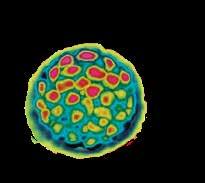
66 minute read
CONTROL AND REGULATION
How does your body respond to change?
CHAPTER
3.1 Receptors detect stimuli 3.3 The nervous system controls reflexes 3.5 Things can go wrong with the nervous system 3.6 The endocrine system causes long-lasting effects 3.7 Homeostasis regulates through negative feedback 3.8 Science as a human endeavour: Hormones are used in sport Science as a human 3.9 endeavour: Pathogens cause disease 3.10 The immune system protects our body in an organised way 3.11 Things can go wrong with the immune system
Nerve cells are called neurons3.2 The central nervous system controls our body3.4 What if? Exploring your senses What you need: Blindfolds What to do: 1 With a partner, explore how the senses of touch, hearing and smell can be used to navigate around a room without the use of sight. 2 Ensure all small or potentially hazardous obstacles are removed from around the room. Decide with your partner the path that the blindfolded student is required to take around the room. 3 Take turns being blindfolded and navigating the room, with your CONTROL AND REGULATION 3 DRAFT ONLY - NOT FOR SALE partner walking with you to ensure your safe navigation and providing assistance if needed.
What if?
» What if you wore earmuffs as well as the blindfold? » What if you blocked your nose? No part of this publication may be » What if you were barefoot?reproduced, stored in a retrieval system or transmitted in any form or by any means.
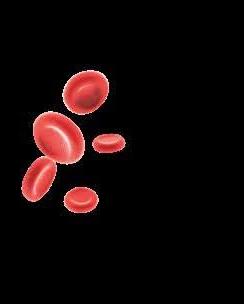
3.1
Receptors detect stimuli
In this
topic, you • Your body has receptors that detect changes (stimuli) in the environment. will learn • The five main types of external receptors detect light, sound, chemicals in the air that: and in your mouth, and touch. stimulus any information that the body receives that causes it to respond receptor a structure that detects a stimulus or change in the normal functioning of the body
Figure 2 We often respond to hot weather by drinking more. Figure 1 The human papillomavirus (seen here under a microscope) stimulates an immune response in the human body.
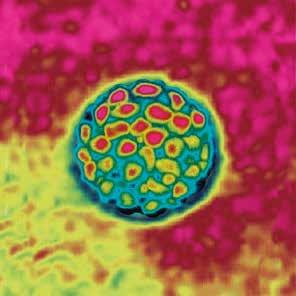
Your body responds to changes in its environment. Receptors detect these changes and pass the information to other parts of the body. A stimulus is any information that your body receives that might cause it to respond. Responding to change Within our bodies, we regularly respond to changes without being aware of a stimulus and response. What makes you aware that you’re hungry or thirsty? Something in your body is communicating with your brain to tell you to find food or water. A similar process occurs when you feel tired or have a headache. What is the source of these stimuli? Other examples of stimuli are less obvious. We are surrounded by bacteria, viruses and fungi. Although many of them are too small to see, our bodies are constantly monitoring their numbers and fighting off harmful micro-organisms. Your body is an amazing combination of cells, tissues, organs and systems, all working together. Each plays a part in detecting stimuli and passing on the information to other parts of the body. The structures that receive stimuli are called receptors. Video 3.1 How taste works Interactive 3.1 The human ear The sense organs Our body can detect five main signals: light (sight), sound (hearing), chemicals in the air (smell) and in our mouth (taste), and touch. These are external senses because they tell us about the world outside our body. The sense organs – the eyes, ears, tongue, nose and skin – are highly specialised to receive stimuli from the environment. Sight Sight tells us more about the world than any DRAFT ONLY - NOT FOR SALE other sense. The pupils change size to control how much light enters the eye. The different types of photoreceptor cells at the back of the eye transform the light into nerve signals for the brain. It is not only your eyes that allow you to
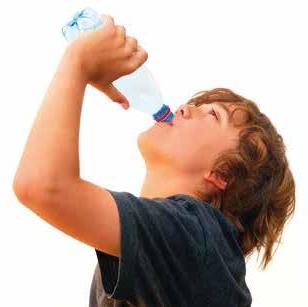
The lens focuses incoming light.
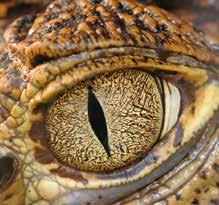
The cornea bends incoming light.
The iris controls the amount of light entering the eye. Photoreceptor cells in the retina change light into nerve signals.
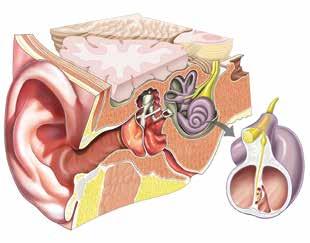
Nerve impulses travel through the optic nerve to the brain.
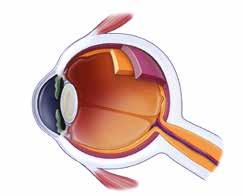
Figure 4 Photoreceptors in the human eye transform light into nerve signals. Sounds enter the ear through the ear canal.
see, but also your brain! The information from your eyes is transferred to your brain, which then tells you what you are seeing. Hearing The strumming of a guitar causes the particles in the air to vibrate. This in turn causes your eardrum to vibrate. The vibrations are transferred along the bones of the middle ear – the smallest bones in your body – and converted into nerve impulses. The brain then interprets the information, telling you what you are hearing. Nerve impulses travel through the auditory nerve to the brain.
Figure 5 The large ears of some bats help them use sound waves to locate their prey. Figure 3 A crocodile’s eye has an elliptical (ovalshaped) pupil, which helps to protect its sensitive retina from the bright light of day. DRAFT ONLY - NOT FOR SALE Eardrum
Vibrations passing through the middle ear are changed to nerve impulses. The cochlea contains uid that moves due to vibrations coming from the middle ear. This motion becomes an electrical signal that is passed to nerve cells.
Taste Smell
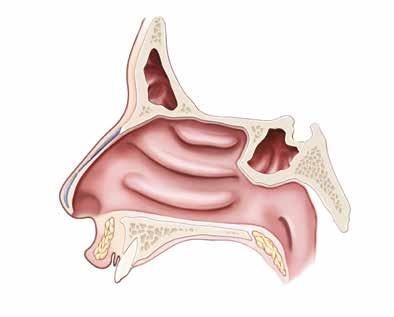
Your tongue is covered in thousands of tiny taste buds. You can see this in a mirror. Taste buds contain special receptor cells that react to chemicals in foods. These chemical receptors can recognise basic kinds of taste molecules, such as sweet, salty, sour, bitter and umami (savoury). When you eat or drink, the information from the taste receptor cells is sent to your brain through nerves. It is the mix of chemical molecules that your brain detects as the flavours you are tasting.
Like taste, our perception of smell depends on chemical receptors. The receptors in our nostrils detect chemicals in the air and then send messages to the brain, which interprets the messages and tells us what we are smelling. Smell is closely linked to taste. If this seems strange, think about the last time you had a bad cold and a blocked nose. Did it affect your ability to taste? A lot of what people think is taste is actually smell. Smell receptors above nasal cavity stimulate olfactory bulb, which sends messages to brain. Mucus provided by nasal sinuses helps to trap bacteria and small particles. Air moves through nasal cavity to back of throat. Figure 7 A dog uses its tongue for many things, including taste and temperature control. Panting moves cool air over the tongue and lungs, allowing moisture to evaporate and thus cooling the body. Figure 8 The tongue is covered in bumps, called papillae, which contain tastebuds that enable us to taste. A supertaster has many more papillae than average, and a non-taster has fewer. Non-taster tongue Supertaster tongue Papillae DRAFT ONLY - NOT FOR SALE
Figure 9 Elephants use their trunks for a wide range of smelling tasks, such as sensing danger. Air enters nose through nostrils. Air travels to trachea and into lungs.
Figure 10 Smell receptors in human nostrils detect chemicals and send messages to the brain.
Touch
While the other four senses are in specific locations, touch is felt all over the body, through the skin. The inner layer of skin, called the dermis, contains many nerve endings that can detect heat, cold, pressure and pain. Information is collected by the different receptors and sent to the brain for processing and reaction. Sweat pore Hair Epidermis
Papillae Capillaries near Dermis surface of skin Subcutaneous fat layer
Sweat gland
Hair root Blood vessels Figure 12 A cross-section of human skin
Remember and understand 1 Define the term ‘stimulus’. 2 Stimuli can be changes in our immediate environment or changes within our bodies. Describe two examples of each. 3 Identify the five major sense organs.
Apply and analyse 4 Describe two situations in which each sense organ would need to respond. 5 Compare (similarities and differences between) the way you detect smell and the way you detect taste.
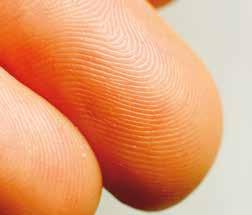
3.1 Check your learning 6 ‘A person has more than five senses.’
Evaluate this statement by: • describing the five senses that are being referred to • describing what happens to your balance when you spin around quickly (sense of balance) • describing how your body reacts when you are sick (sensing bacteria) • deciding whether the statement is correct.

Figure 11 The skin of a human fingertip has about 100 touch receptors. DRAFT ONLY - NOT FOR SALE
3.2
Nerve cells are called neurons
In this
topic, you • Neurons are cells in our body that enable messages to be passed quickly. will learn • A change is detected by the receptor and an electrical message is passed along the that: neuron to the synaptic terminal. • Chemical neurotransmitters pass the message across the gap to the next neuron. • The myelin sheath protects parts of the neuron and increases the speed of messages being sent. Nerves The basic unit of the nervous system is the nerve cell, or neuron. Scientists believe that we may have up to 100 billion neurons in our bodies, connected in paths called nerves. Neurons have many highly specialised features. Each neuron has a large cell body that connects to a long thin axon (Figure 1). An axon carries nerve impulses away from the cell body. The axons connecting your spinal cord to your foot can be up to 1 m long. At the end of the axon are small bulbs, called synaptic terminals. Each synaptic terminal releases information into the synapse (Figure 2). The next neuron receives these messages from the synapse via its dendrites. Nerves work just like electrical wires and require insulation in the same way. The axons are covered by a fatty layer called the myelin sheath. The myelin sheath helps to speed up a nerve impulse along an axon by controlling its path. People with multiple sclerosis have damaged myelin sheaths. This means that the nerve impulse is disrupted, blocked or unable to move along the length of the axon. A person with multiple sclerosis can therefore have difficulties with movement. Dendrites are nerve endings that branch out of the cell body. These highly sensitive, thin neuron branches receive information from the synaptic a nerve cell terminal of other neurons, allowing nerve cell body impulses to be transmitted. the main part of a cell that contains the nucleus/ genetic material axon the part of a neuron (nerve cell) that carries an electrical message away from the cell body to the synapse myelin sheath a fatty layer that covers the axon of a nerve cell dendrite the part of a neuron (nerve cell) that receives a message and sends it to the cell body Cell body (soma) Nucleus Myelin sheath
1 Electrical impulse passes along neuron Neurotransmitters stimulated 2 Neurotransmitters cross the synapse DRAFT ONLY - NOT FOR SALE
Dendrites Axon Direction of impulse
Synaptic terminal (axon terminal)
Figure 2 Electrical messages are converted to chemical messages (neurotransmitters), which cross the gap in the synapse.
Remember and understand interneuron a nerve cell that links sensory and motor neurons; also known as a connector neuron motor neuron a nerve cell that carries a message from the central nervous system to a muscle cell
1 With a partner, create a way to remember the difference between sensory neurons, motor neurons and interneurons. Be creative!
Share your memory trick with the class. 2 Describe the features of a neuron that enable it to pass messages on to other neurons. 3 Describe where you will find sensory neurons that detect: a smell c sound e light. b taste d touch
3.2 Check your learning 4 Describe the role of the myelin sheath. Apply and analyse 5 Use a diagram to explain the problem that may result from damage to the myelin sheath. 6 Compare (the similarities and differences between) sensory neurons and motor neurons. 7 Contrast (the differences between) sensory neurons and interneurons.
Dendrites bring information to the cell body and axons take information away from the cell body. Information from one neuron flows to another neuron across a synapse. The synapse is a small gap separating neurons. When the message reaches the end of the axon, chemicals called neurotransmitters are released from the synaptic terminal and travel across the gap in the synapse to the dendrite of the next neuron. In this way, electrical messages are passed around the body.
There are three specialised types of neuron, all with different jobs. > Sensory neurons (or afferent neurons) are sensitive to various stimuli, collecting information from either the body’s internal environment or the outside world. Sensory neurons send the information they have collected to the central nervous system for processing. > Interneurons (or connector neurons) link sensory and motor neurons, as well as other interneurons. Figure 3 In these examples of an interneuron, a sensory neuron
Interneurons are the most common neuron in your and a motor neuron, you can see how they are structured differently to send and receive different messages. synapse a small gap between central nervous system two neurons that (brain and spinal cord). must be crossed by
They only make connections neurotransmitters with other neurons. neurotransmitter a chemical messenger that crosses the synapse between the axon of one neuron and the dendrite of another neuron sensory neuron a nerve cell that carries a message from a receptor to the central nervous system
Axon Cell body
Interneuron Axon terminal Neurilemma Myelin sheath Schwann Dendrites cell nucleus Node of Ranvier Schwann cell nucleus Cell body Axon Dendrites Node of Ranvier
Sensory Neuron Neurilemma
Myelin sheath Sense organ Motor Neuron
Cell body Axon
Effector Schwann cell nucleus Dendrites Skeletal muscle Node of RanvierMyelin sheath Neurilemma > Motor neurons (or efferent neurons) carry messages from the central nervous system to muscle cells throughout the body, which then carry out the response. DRAFT ONLY - NOT FOR SALE
3.3
The nervous system controls reflexes
In this
topic, you • Receptors in the nervous system detect a stimulus and pass it on to control centres. will learn • The control centres initiate a message to the effectors, which causes a response.
that:
• Reflexes are special pathways that allow a response to occur before the brain has time to think. Stimulus–response model Reflexes Stimuli can be in many different forms. A If you have ever accidentally touched something stimulus may be pressure or heat on the very hot, you will remember how quickly you skin, a puff of air or strong light in your snatched your hand away. In fact, it would have eye. The stimulus is detected by receptors been so quick that you didn’t even have time to and the message gets sent to the spinal cord think about it – it was automatic. reflex and the brain via sensory neurons. The A reflex, or reflex action, is an involuntary an involuntary movement spinal cord and brain are the control centre and nearly instantaneous movement in response in response to a stimulus of the nervous system. Interneurons in this to a stimulus. control centre pass the message on to other During a reflex action, the sensory neuron interneurons as your brain thinks about carries the message from the receptor to the how you should respond to the stimulus. spinal cord. The interneuron then sends two Stimulus Eventually, you make a decision and the messages at the same time: one to the brain and motor neurons pass the message on to the the other to the muscles via the motor neuron. muscles. In this case, the muscles are This means the muscle is moving at the same called the effectors, as they are the cells time as the brain gets the message (e.g. that Receptor that cause the body to respond. This simple the object is hot). This makes reflexes even pathway is called the stimulus–response faster than usual responses. Most reflexes help Via sensory model (Figure 1). us in survival situations. Can you think of the neuron advantages of these reflexes? Control centre Effector Via motor neuron Response Figure 1 The stimulus–response model Sensory receptors
Sensory neuron Interneuron Motor neuron Spinal cord Video 3.3 Microscope skills DRAFT ONLY - NOT FOR SALE
Figure 2 A reflex action ensures that your hand pulls away from the flame very quickly, even before you feel the pain.
Remember and understand 1 Define the following terms. a stimulus b receptor c effector d response 2 Describe the stimulus–response model of regulation. Apply and analyse 3 Explain why the brain is not involved in a reflex action.
Figure 3 Grasp reflex. When an object is placed on a baby’s palm, their fingers curl over and grasp it. 3.3 Check your learning 4 Explain the advantage of a baby having the startle reflex. 5 If a person has a damaged upper spinal cord, they may not be able to feel their toes. Analyse whether this will affect their knee-jerk reflex (by describing how a person ‘feels’ their toes, describing the role of the spinal cord in a knee-jerk reflex and determining whether damage to the upper spinal cord will affect the messaging in a knee-jerk reflex).
Figure 4 Sneezing reflex. When small particles land on receptors in the back of your nose, the muscles in your diaphragm force air out rapidly. Figure 5 Startle reflex. When a newborn baby is startled, they will fling their arms out wide and grab anything they touch. Figure 6 Plantar reflex. When a blunt object (such as the blunt end of a pencil) is moved along the underside of the foot, the toes usually curl downwards.
Figure 7 Patellar (knee-jerk) reflex. When a small section below the kneecap (the tendon that connects the muscle to the bone) is stimulated with a quick, firm tap, the foot will kick out. Figure 8 Quick reflexes! DRAFT ONLY - NOT FOR SALE

3.4
The central nervous system controls our body Sacral nerves Lumbar nerves Thoracic nerves Spinal cord Brain stem Cerebellum Cerebrum > Humans are constantly receiving stimuli from their environment through the peripheral nervous system. > Neurons use electrical messages that are passed along to neurons in the brain and spinal cord that make up your central nervous system. Central nervous system The central nervous system is the control centre of the body. All incoming messages from your environment and your responses to them are processed through your central nervous system. The two main parts of the central nervous system are the brain and the spinal cord. Brain The brain is the processing centre of the body and is mainly concerned with your survival. It is a soft, heavy organ surrounded by a tough skull. The interneurons in the brain gather information about what is going on inside and outside the body. It then compares the information to events that have occurred previously, before making decisions about things such as internal changes and movements. The brain is also home to your memories, personality and thought processes. Lobes of the brain The cerebrum, or outer section of the brain, is divided into four lobes or sections. These lobes have specific functions. > The frontal lobe is at the front of the brain. Its functions include emotions, reasoning, movement and problem-solving. > The parietal lobe manages the perception of senses, including taste, pain, pressure, In this topic, you will learn that: central nervous system the brain and spinal cord Video 3.4 The core of the nervous system DRAFT ONLY - NOT FOR SALE temperature and touch. > The temporal lobe is in the region near your ears. It deals with the recognition of sounds and smells. Figure 1 The nervous system of the body is made up of the central nervous > The occipital lobe is at the back of the brain. system and the peripheral nervous system. It is responsible for the various aspects of vision.

Peripheral nervous system The peripheral nervous system is a large system made up of all the nerves outside the central nervous system. The peripheral nervous system carries information to and from the central nervous system to the rest of the body, such as the limbs and organs.
The peripheral nervous system is divided into two parts. > The somatic nervous system controls voluntary skeletal muscle movements, such as waving or reaching out to take an object. > The autonomic nervous system controls involuntary actions, which happen without our conscious control. This includes heartbeat, digestion, respiration, salivation and perspiration. The autonomic nervous system maintains your body’s internal environment (homeostasis).
The autonomic nervous system also has two parts: the sympathetic division and the parasympathetic division. These two divisions often have opposite effects. For example, the parasympathetic division slows down the heart rate, whereas the sympathetic division speeds up the heart rate. The systems work together to maintain a balance in the body.
Remember and understand 1 Identify the two parts of the body that make up the central nervous system. 2 Describe the role or function of the peripheral nervous system.
Apply and analyse 3 Draw a scientific diagram of the brain that shows the four lobes. In each of the lobes: a write the functions that are carried out in that lobe b draw something to remind you of the functions carried out in that lobe.
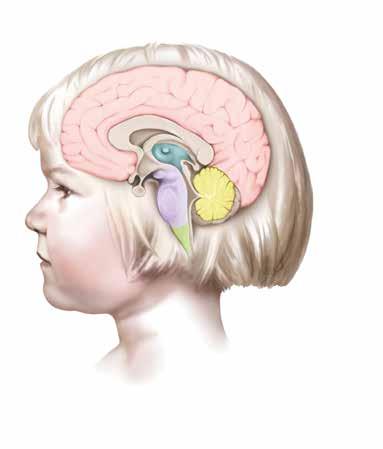
Frontal lobe Cerebrum 3.4 Check your learning peripheral nervous system all the neurons (nerve cells) 4 Describe how the peripheral nervous that function outside the system and the central nervous system brain and spinal cord work together. Use an example to somatic nervous system illustrate your answer. the part of the nervous system 5 Explain why, if you slipped and hit the that controls the muscles back of your head, everything might go attached to the skeletal system black. autonomic nervous system 6 Contrast (the differences between) the part of the nervous the somatic nervous system and the system that controls involuntary actions such autonomic nervous system. as heartbeat, breathing 7 Describe the possible effect on and digestion behaviour that would occur if a person had damage to the frontal lobe of their brain.
The thalamus processes and carries messages for sensory information, such as information sent from the ears, nose, eyes and Parietal lobe skin, to the cortex. Occipital lobe
The medulla is the bottom part of the brain stem and controls automatic functions, such as respiration (breathing) and digestive system activities.
Figure 2 The cerebrum (the large pink area) is divided into four lobes, each with a specific The cerebellum is important in the fine control of movement, balance and coordination. The brain stem sits mostly inside the brain. At its base it becomes the spinal cord. The brain stem is made up of three major parts – the medulla, the pons and the midbrain. The pons assists in some automatic functions, such as breathing, and also controls sleep and arousal. The midbrain contains areas that receive and process sensory information, such as movement and vision. Figure 3 Structure of the human brain. The fourth lobe of the cerebrum, the temporal lobe (not shown here), is near the ears. function. DRAFT ONLY - NOT FOR SALE
3.5
Things can go wrong with the nervous system
In this
topic, you • A slipped disc can press on the nerves in the spinal cord. will learn • When the myelin sheath is damaged in multiple sclerosis, the movement of the that: body can be affected. • Motor neurone disease affects messages being passed to the muscles. • Alzheimer’s disease is caused by progressive damage to neuron functioning. The nervous system plays a very important role called a disc, which is filled with a thick fluid, in coordinating and regulating your body. Things or gel, and allows the vertebrae to move. If a that can go wrong with the nervous system include disc becomes weak and puts pressure on the the spinal cord being damaged (paraplegia), nerves entering or leaving the spinal cord, this things pressing on the nerves in the spinal cord will cause pain or numbness along the nerve. (slipped disc), the myelin sheath in neurons being Treatment usually involves pain relief, along damaged (multiple sclerosis), the motor neurons with exercises that strengthen the muscles in failing (motor neurone disease) and damage to the the back. Occasionally, surgery is required to neurons in the brain (Alzheimer’s disease). remove the damaged part of the disc. Spinal damage Multiple sclerosis Spinal injury is a major type of injury in The myelin sheath plays a very important role Australia, especially in young men. These in ensuring the electrical message passes along injuries commonly result from motor vehicle the axon of a neuron. If the myelin sheath is accidents, everyday falls and sports. damaged, the electric signal can be lost, like a When the spinal cord is damaged, the broken wire in an electric circuit. Your immune messages from the neurons below the level of system usually fights and kills bacteria and viral injury can no longer travel to the brain. This infections. In multiple sclerosis, the immune means the individual cannot receive messages system mistakenly recognises myelin sheath from the sensors in this part of the body. It also cells as dangerous, and attacks and destroys means the messages from the brain cannot reach them. This means messages to and from the past the injury. How much of the body is able to senses (including the eyes, skin and bladder) Spinal nerve move after a spinal injury depends on where the and the muscles become lost. Muscles can Ruptured disc injury is in the spinal cord. If it is high up, most become weak, and the sufferer can feel dizzy or pressing on of the body is ‘cut off’ from the brain; if it is tired, or have difficulty seeing properly. Most spinal nerve lower down, then the upper body and arms may commonly, the symptoms appear for a short
Lumbar be able to work as they normally would. time, before disappearing completely, and then vertebrae People with severe damage to the upper returning later on. This is called a relapsing–
Normal part of the spinal cord have quadriplegia – they remitting cycle. healthy disc are unable to use their arms or legs. If the injury is very high, they may even have trouble Motor neurone disease breathing on their own. People with severe damage below the arms have paraplegia – they In motor neurone disease (also known as are still able to use their arms but not their legs. amyotrophic lateral sclerosis, ALS), the neurons that send messages to the muscles Slipped disc become weak and eventually lose function. As the muscles grow weaker, they can cramp and Your backbone consists of 26 bones, or become stiff. This usually starts in the muscles vertebrae, that surround the nerves of your in the legs and arms, before progressing to the spinal cord. Between each vertebra is a sac face and chest. This can affect the person’s
Ruptured discs DRAFT ONLY - NOT FOR SALE Figure 1 The vertebrae in your spine are separated from each other by fluid-filled discs. Rupturing of a disc can put pressure on the spinal nerves. Top: X-ray of spine, showing two ruptured discs. Bottom: A ruptured disc presses on the spinal nerve, causing pain.
Dendrites
Cell body Neuron ability to talk and, eventually, to breathe. Neurons in the brain are also affected by this disease. Scientists do not know what causes the motor neurons to lose function. Research in this area is continuing.
Alzheimer’s disease Alzheimer’s disease is caused by progressive damage to the neurons in the brain. This gradually affects memory, and the ability to reason or plan and carry out everyday activities. Problems with short-term memory mean that the sufferer cannot remember what happened a few hours ago, or what they are meant to be doing that day. The disease also has wider impacts. Sufferers can forget where they are and how to get home. This makes life very confusing for them and they can become upset very easily. Symptoms can vary from day to day, depending on tiredness or stress. The cause of Alzheimer’s disease is not known. Research suggests that plaques develop around neurons in the brain, making it hard for them to transmit messages. Chemical changes in the neurons may be caused by genetic, environmental and health factors.
Nucleus Myelin sheath Synapses Figure 3 AFL legend Neale Nucleus Daniher was diagnosed with Axon motor neurone disease (MND) in 2013. Daniher’s diagnosis has increased awareness and Myelin fundraising for MND. Normal nerve Damaged myelin Damaged nerve Figure 2 The myelin sheath surrounds the axon and helps electrical messages to move along the nerve. In multiple sclerosis, damage to the myelin sheath prevents the nerves from passing on messages.
Remember and understand 1 Identify the name of the individual bones that make up the spine. 2 Contrast quadriplegia and paraplegia. 3 Describe the role of a disc in the spinal column. 4 Explain why the destruction of the myelin sheath causes symptoms in multiple sclerosis.
3.5 Check your learning 5 Identify another name for motor neurone disease. Describe the role motor neurons usually play in a healthy nervous system. Apply and analyse 6 Think about where you were and what you were doing one hour ago. Describe how you would be affected if you could not remember this.
Cerebral cortex Figure 4 Damage to the neurons in Alzheimer’s disease can cause the brain to shrink. a Normal brain b Brain of a person with Alzheimer’s disease
Extreme shrinkage of cerebral cortex Severely enlarged ventricles Extreme shrinkage Hippocampus Entorhinal of hippocampus cortex Cross-section of normal brain
Cross-section of Alzheimer’s brain a b DRAFT ONLY - NOT FOR SALE
3.6
The endocrine system causes long-lasting effects
In this
topic, you • The endocrine system uses chemical messengers called hormones to maintain will learn control and to regulate growth. that: • Hormones travel through the bloodstream to receptors or target cells. • The effects of hormones often last longer than the effects of the nervous system. The endocrine system is a collection of glands that secrete (release) hormones. The hormones are secreted directly into the bloodstream and then travel around the body endocrine system through the blood. Some cells in the body a collection of glands that have receptors that match the hormone, like make and release hormones a lock to a key. These cells are called target hormone cells. It only takes one hormone ‘key’ to cause a chemical messenger a change in the target cell ‘lock’. that travels through blood The glands and organs of the endocrine vessels to target cells system are spread throughout the body (see target cell Table 1 and Figure 1). a cell that has a receptor that matches a specific hormone Table 1 Some organs and hormones of the endocrine system Organ Hormone Target tissue Main effects Hypothalamus Wide range of neurohormones Pituitary gland Sends messages from nervous system to the pituitary gland to control functions such as body temperature, hunger, thirst and sleep patterns Ovaries Progesterone Uterus Thickens wall of uterus to prepare for pregnancy Oestrogen Body cells Development of female sexual characteristics; aspects of pregnancy and foetal development Testes Testosterone Male reproductive system, body cells Development and control of male sexual characteristics; production of sperm Pancreas Insulin Liver, most cells Lowers blood glucose level Glucagon Liver Raises blood glucose level Pituitary gland Thyroid-stimulating hormone Thyroid Changes the rate of thyroxine release from the thyroid Antidiuretic hormone Kidneys Reduces the amount of water reabsorbed from the kidneys Pituitary growth hormone
Bones, muscles Stimulates muscle growth; controls the size of bones Thyroid gland Thyroxine Body cells Affects rate of metabolism, and physical and Fight, flight or freeze? If you are ever in a dangerous or frightening situation, you may experience a ‘fight, flight or freeze’ response. You break out in a cold sweat, your heart beats wildly, everything around you seems to slow down and your senses bombard you with information. Most of these symptoms are triggered by the release of the hormone adrenalin (also called epinephrine). Adrenalin is constantly produced by the adrenal glands in small doses. Video 3.6 The endocrine system DRAFT ONLY - NOT FOR SALE mental development
Parathyroid glands
Parathyroid hormone Adrenal glands Adrenalin
Pineal gland Melatonin Blood
Body cells
Skin cells Regulates the amount of calcium in the blood
Increases body metabolism in ‘fight or flight’ response Involved in daily biological rhythms
Remember and understand 1 Identify the name of the system in your body that is responsible for hormones. 2 Describe what is meant by the phrase
‘fight, flight or freeze’ and how it relates to hormones. 3 Describe the symptoms of a panic attack. 4 Explain why the endocrine system is referred to as a communications system.
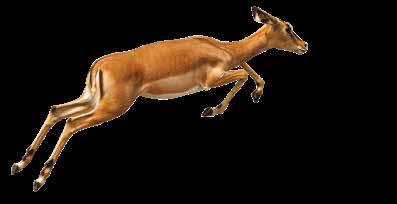
The adrenal glands are located above the kidneys. The usual function of this hormone is to stimulate the heart rate and enlarge blood vessels. However, when you are in danger, adrenalin takes on another role. It floods your system, causing an increase in the strength and rate of the heartbeat, raising your blood pressure and speeding up the conversion of glycogen into glucose, which provides energy to the muscles. In this way, adrenalin prepares your body for the extra effort required should you need to defend yourself (fight), run away (flight) or hide (freeze). Panic attacks Sometimes the ‘fight, flight or freeze’ response can be triggered without any obvious reason. This means adrenalin can flood the body, causing the heart to pound, breathing to become fast and shallow, and a flood of sensory information to stimulate the brain. When this occurs, lights appear brighter, sounds are louder and smells stronger. These sensory messages can become jumbled as the brain struggles to make sense of all the information. This combination of endocrine and nervous system responses is called a panic attack. These symptoms are not life threatening and will eventually disappear. Support from friends and family can help. 3.6 Check your learning Apply and analyse 5 Compare (the similarities and differences between) a hormonal response and a nervous response. Describe one advantage for each system. 6 Explain why telling someone to ‘calm down’ during a panic attack will not stop their symptoms. (HINT: Are they able to control their hormones?)
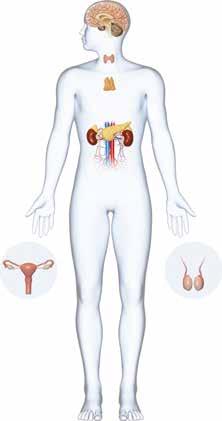
Pituitary gland Hypothalamus Pineal gland Thyroid gland Thymus PancreasAdrenal gland Kidney TestesOvaries FEMALE MALE Figure 1 The human endocrine system Figure 2 Adrenalin is responsible for the 'fight, flight or freeze' response in mammals and can help them to survive. DRAFT ONLY - NOT FOR SALE

3.7
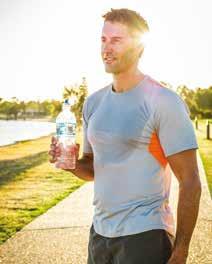
Homeostasis regulates through negative feedback • The body needs to detect and correct changes in its levels of nutrients, water and temperature to stay healthy. • The process of regulating the internal conditions of the body is called homeostasis. • Negative feedback occurs when the body responds in a way that removes the initial stimulus. In this topic, you will learn that: Homeostasis To maintain homeostasis, your body uses a mechanism that is similar to a thermostat in a heater. When temperature receptors on your skin and in the hypothalamus of your brain detect cooling down (stimulus), a message gets sent to a variety of effectors around your body. Effectors are glands or muscles that cause a change in the way your body functions. This may include muscles to make you shiver (to warm up) or blood vessels to redirect the flow of warm blood to the important organs in your body (heart, liver and brain). If the temperature receptors detect that you are too hot (stimulus), then the effectors include your sweat glands and blood vessels. Scientists have not yet discovered another planet that humans could inhabit. Humans can only survive in very specific environments. Our bodies have particular requirements, including the right amount of food and water, oxygen and carbon dioxide. If you were lost in a desert or in freezing temperatures, your body would try to maintain a temperature of about 37°C at all times, to keep all cells working efficiently. This ‘business as usual’ approach of responding to stimuli to maintain a stable state is called homeostasis.homeostasis the process by which the body detects and responds to stimuli to ensure a stable internal state is maintained DRAFT ONLY - NOT FOR SALE

Figure 1 Homeostasis is your body’s ability to regulate and maintain a stable condition (balance) inside your body, regardless of changes to the external environment. Figure 2 When your body is stimulated by heat, homeostasis ensures you cool down by sweating.
Your body responds by sending more blood, which is carrying heat, to your skin, where sweat is evaporating, carrying away the heat and cooling you down. This a negative feedback mechanism – the effectors respond and, as a result, remove the stimulus. If you are too hot, then your body tries to cool you down. If you are too cold, then your body works to warm you up. Hormones at work The rate of hormone production and secretion is often regulated by a negative feedback mechanism. If a stimulus is received that indicates something in the body is happening ‘too much’, the body has receptors to detect it. The body responds by producing a hormone to remove the stimulus and return the body to normal. Blood glucose As you eat, food gets broken down into smaller nutrients. All carbohydrates get broken down into simple sugars, including glucose. These glucose molecules travel through your blood and provide energy for cellular respiration (the reaction of glucose with oxygen to produce carbon dioxide, water and ATP). Too much glucose in the blood is not healthy, because it causes water to be lost from cells through osmosis. Your body tries to control the amount of glucose in your blood. If the concentration of glucose in your blood is too high (stimulus),
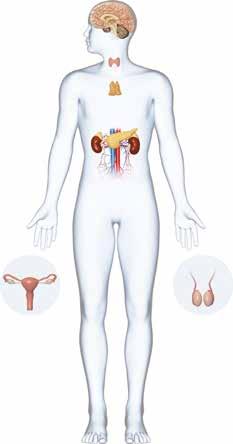
negative feedback mechanism a regulatory loop in which the stimulus causes a response that acts in the opposite direction to whatever is being regulated Blood sugar level
Pineal glandPituitary gland Hypothalamus Thyroid gland Thymus Adrenal gland Pancreas Kidney Figure 4 The pancreas is the endocrine organ responsible for the regulation of blood glucose levels. Pancreas receptors respond and release insulin Glucose increases Liver changes glucose to glycogen Healthy glucose level Glucose decreases

then receptors in the pancreas detect it. They then release a hormone called insulin into the blood. Insulin travels throughout the body to insulin receptors on the target muscle and liver cells. These cells then act as effectors and remove glucose from the blood. This causes the blood glucose to decrease, removing the original stimulus. This is an example of negative feedback. If blood glucose levels are too low, your body will use negative feedback to restore levels to a homeostatic state. Low glucose levels are detected by receptors in the pancreas (stimulus). This time, the hormone glucagon is released into the blood. Receptors for glucagon are also found on the effector cells in the liver and muscles. Glucagon binding to the receptors causes the muscle and liver cells to release stored glucose into the blood (response), increasing the amount of blood glucose once again. DRAFT ONLY - NOT FOR SALE
Liver releases its glycogen store as glucose Pancreas receptors respond and release glucagon Figure 3 The pancreas and the liver work together to maintain healthy glucose levels in the body.
1 hour 2 hours
Time after eating
Figure 5 After you eat, your blood glucose levels increase. The body’s response is to release insulin, which causes the muscle and liver effectors to remove the glucose and restore homeostasis.
Figure 6 Water controls the chemical reactions that occur in cells.
Water regulation
Water content of the blood LOW Water content of the blood HIGH
Urine output LOW
Brain produces more ADH Urine output HIGH
Brain produces less ADH High volume of water reabsorbed by kidney
Too much salt or sweating Low volume of water reabsorbed by kidney
You may have noticed that when you drink lot of water, you need to visit the bathroom in the next hour. Your body uses homeostasis to control the balance of water in your body. Water is needed to control all the chemical reactions that occur in the cells. If there is too much or too little water, these chemical reactions will be affected and the cells can become damaged. The water balance in your body is tightly controlled by the hypothalamus in your brain. If it has been a hot day, or you have been doing physical exercise and sweating, then your body may have lost a lot of water. Receptors in the hypothalamus of the brain detect changes in fluid levels in your blood and send a message to the pituitary gland at the base of your brain. The pituitary gland releases a chemical messenger called antidiuretic hormone (ADH) into your blood. This hormone travels all Too much water drunk Water content of the blood normal around your body until it reaches target effector cells in your kidney. The ADH binds to the receptors on the effector cells, causing them to reabsorb extra water from your urine. This makes your urine more concentrated or darker in colour. The extra water that was reabsorbed goes back into the blood, keeping the blood volume high. This is a form of negative feedback, as the response (reabsorbing water from the urine and returning it to the blood) results in a decrease of the stimulus (improving water levels in the blood). Drinking a lot of water causes the blood volume to increase. This is also detected by receptors in the hypothalamus. This time the message to the pituitary gland is ‘STOP producing ADH’. The lack of ADH is detected by the effector cells in the kidney, and they stop reabsorbing water from the urine. This means the urine has more water in it, and it becomes very clear and diluted. DRAFT ONLY - NOT FOR SALE
(small volume of concentrated urine) (large volume of diluted urine)
Figure 7 Water regulation in the human body
Oxygen and carbon dioxide homeostasis
Have you ever wondered why you become puffed when running a race? Oxygen and carbon dioxide in the blood are under strict homeostatic control. You need the oxygen for cellular respiration in a cell. Carbon dioxide is the waste product of this reaction.
Sprinting during a race causes the muscle cells in your legs to use a lot of glucose and oxygen and to produce a lot of carbon dioxide. The muscle cells release the carbon dioxide into the blood, where it forms carbonic acid. This is not good for your body. The acid content of the blood is measured by receptors in the medulla in the brain stem. If the level is too high from excess carbon dioxide, a message is sent through the nervous system to the muscles that control your breathing. This causes the diaphragm to move faster, increasing the rate of your breathing and making you feel puffed. The message also goes to the heart to make it beat faster. This makes the blood move faster, carrying the carbon dioxide to the lungs where it can be removed by breathing out. These two responses act as negative feedback, removing the stimulus of high levels of carbon dioxide in the blood.
Meditation often involves sitting or lying down and relaxing. This means the level of cellular respiration in muscles is low. Little oxygen is used and little carbon dioxide is produced. As a result, the levels of carbon dioxide in the blood decrease. The receptors in the medulla once again detect the change from the homeostatic state and signal the heart to slow its beat and the lungs to slow their breathing.
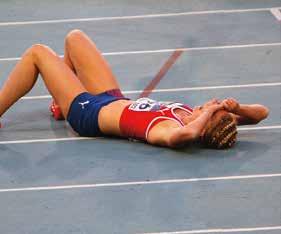
Figure 8 After a race, you may be puffed. Remember and understand 1 Define the term ‘homeostasis’. 2 Describe how your body responds to cold weather. 3 Describe how your blood sugar level changes when you eat. 4 Describe how your body responds to low blood sugar levels. Apply and analyse 5 Identify the stimulus, location of receptors, effectors and response to high body temperature. 6 If a negative feedback loop reduces the effect of a hormone, describe what a positive feedback loop should do.
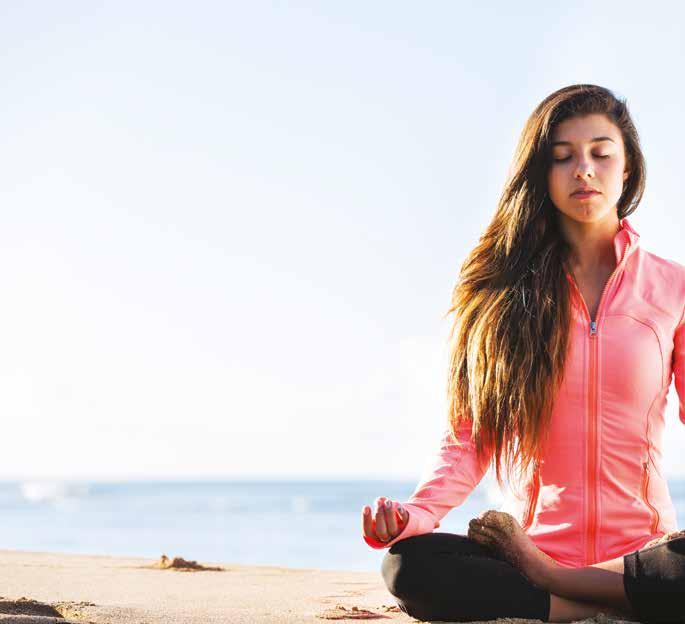
Evaluate and create 7 In type 1 diabetes, cells in the pancreas are unable to produce insulin. Predict what effect this would have on blood glucose levels. Research how people with type 1 diabetes ensure that their blood glucose levels remain at the homeostatic level. 8 Describe how and why your body responds to the following: a drinking a bottle of water b swimming 15 m under water c swimming in the ocean on a cold day. 3.7 Check your learning Figure 9 When you meditate, the carbon dioxide levels in your body decrease. DRAFT ONLY - NOT FOR SALE
//SCIENCE AS A HUMAN ENDEAVOUR//
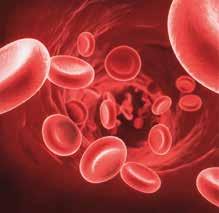
erythropoietin is produced by the kidneys. The erythropoietin travels through the blood to receptors in the bone marrow. The effector bone marrow cells then produce more red blood cells to replace those lost. Exercising at a high altitude stimulates the body to react as though there are not enough red blood cells to carry oxygen to the muscles. Erythropoietin is produced, causing the bone marrow to make extra red blood cells. It takes about three weeks for the extra cells to become noticeable. When the athlete returns to sea level to compete, the red blood cells remain active for up to a month. This means the athlete’s blood is more efficient at carrying oxygen to muscles, making the athlete less likely to become fatigued (tired). Training at a high altitude uses the negative feedback mechanism to the athlete’s advantage. Some athletes bypass high-altitude training and inject erythropoietin directly into their blood. This is called blood doping. However, the amounts of hormone introduced into the blood are not controlled. This can cause an over-production of red blood cells, which strains the heart. The athlete is at risk of a heart attack or a stroke. Many athletes and sporting clubs spend months training high in the mountains to help their performance in competitions. The air in the mountains is much thinner. Although it is still 21 per cent oxygen, it is harder for a person to fill their lungs as the particles in the air are spread out further. As a result, when a person first arrives at high altitude, their body struggles to get enough oxygen. This can make the person feel tired, as they are unable to burn the glucose in aerobic cellular respiration. Negative feedback in action The body normally produces just enough red blood cells to carry oxygen around the body. When red blood cells die, a hormone called Erythropoietin is a hormone normally produced by the kidneys to increase the number of red blood cells in the body. Athletes can use this version of a negative feedback mechanism naturally or artificially to increase their performance on the sporting field. Hormones are used in sport3.8DRAFT ONLY - NOT FOR SALE

Figure 2 Erythropoietin increases the production of red blood cells.
Drug testing
Erythropoietin was first synthesised in the laboratory in the 1990s. Unfortunately, it was 10 years before drug testing could distinguish the artificial hormone from naturally occurring erythropoietin. In 2002, at the Winter Olympic Games in Salt Lake City, United States, the first athlete was identified as having a version of erythropoietin in their urine and blood.
Evaluating the ethics in sports
Sport competition prides itself on fairness for all competitors. There are many ways to improve an athlete’s chances of winning a competition, including training, special diets, shaving body hair and wearing special clothing that reduces air resistance. Some athletes undergo surgery to improve their ability to compete. This can include a golfer having laser eye surgery. A runner who has asthma is allowed to use a Ventolin inhaler, but other athletes are not permitted to use hormones to speed their recovery from an injury.
Evaluate the ethics of cheating in sports by deciding which of the following situations
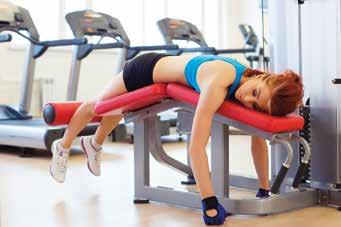
3.8 Develop your abilities should be allowed and which should be banned. In each situation, justify your decision (by describing how the athlete would be advantaged, describing the potential dangers to the athlete, describing whether all athletes would have equal access, and deciding whether the situation could be described as cheating). 1 An athlete takes a dietary supplement that maximises their performance. 2 A swimmer wears an expensive swimsuit that minimises water resistance. 3 An athlete has genetically modified muscles. 4 An athlete takes hormones that increase recovery after injury by increasing muscle mass.
Medical uses of erythropoietin Erythropoietin is produced in the kidneys. Any disease that affects kidney function will also affect the production of erythropoietin. As a result, a person with kidney disease will also have low levels of red blood cells. This is called anaemia. Symptoms of anaemia are a pale appearance and feeling tired when exercising. Regular injections of erythropoietin will increase the production of red blood cells and improve the person’s health. Figure 3 In 2013, Lance Armstrong admitted to injecting erythropoietin to help him win world cycling events.

Figure 4 Anaemia can make you feel tired when exercising. DRAFT ONLY - NOT FOR SALE
//SCIENCE AS A HUMAN ENDEAVOUR//
3.9 Pathogens cause disease Infectious pathogens can disrupt the normal functioning of the called pathogens. Germ theory was confirmed body and cause disease. There are many types of pathogens, including bacteria, fungi, protozoans and viruses. Koch’s by Louis Pasteur and Robert Koch. Robert Koch went on to develop a set of rules, known as Koch’s postulates, that provide postulates are used to provide evidence that a pathogen evidence that a pathogen causes a disease. causes a disease. Penicillin and other antibiotics can be used 1 The micro-organism or other pathogen is to kill bacteria, but not viruses or other pathogens. 2 present in all cases of the disease. The pathogen can be isolated from the diseased host and grown in the laboratory. 3 The pathogen from a pure culture causes the disease when inoculated into a healthy pathogen susceptible laboratory animal. a microbe that can cause 4 The pathogen is re-isolated from the new disease host and is shown to be the same as the originally inoculated pathogen. Australian scientists Barry Marshall and Robin Warren followed these postulates when they researched stomach ulcers in 1984. Together they discovered that a bacterium (Helicobacter pylori) was found in all patients with stomach ulcers. Most doctors at the time thought that no bacterium could survive in the acidic environment of the stomach. Marshall and Warren isolated the bacterium and injected it into mice, causing the disease in the mice. Unfortunately, many doctors still did not believe the research, so Barry Marshall ignored laboratory safety and swallowed a culture of the bacteria, causing the disease in himself.
One of the first people in Western medicine to question the accepted idea of supernatural causes of disease was Hippocrates (460–377 bce). He concluded that something in the air, soil, water and food caused diseases in humans and animals. His work was followed up by Claudius Galen (131–201 ce), who was a doctor to the gladiators, and used animal dissections to explore anatomy.
Girolamo Fracastoro (1478–1553) was an Italian astronomer and doctor who was one of the first to suggest that disease could be transmitted from person to person via small, invisible particles. He theorised that these particles could travel through the air, via contaminated clothing or by direct contact with the sick person. It took 200 years and the discovery of the microscope to confirm his theories and to develop the ‘germ theory’ used today.
Germ theory states that many diseases are caused by the presence and actions of specific micro-organisms. These micro-organisms are Figure 1 Some bacteria keep us healthy. Other bacteria are pathogens and interfere with the natural functioning of our body.
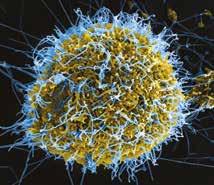
a b DRAFT ONLY - NOT FOR SALE
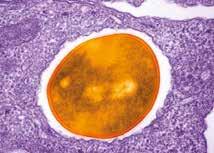
Figure 2 Most infections are caused by microscopic pathogens such as bacteria or viruses. a Bacteria are very small cells that are able to reproduce by themselves. They can release toxins that affect the normal functioning of our body. b Viruses are much smaller than bacteria and are unable to reproduce by themselves. Instead, they invade the host’s cells and use the organelles to make new copies of themselves. This stops the host’s cells from functioning properly.
Cool Wait
Broth heated Flask left open Growth Openflask Wait Broth heated Flask sealed No growth Growth Figure 3 Louis Pasteur’s experiments found that micro-organisms in milk were killed by heat. This process is called pasteurisation and is still in use today. Treatment with antibiotics killed the bacteria and discovered that the Penicillium mould and cured his stomach ulcer. Barry Marshall was releasing a chemical that killed bacteria. and Robin Warren were awarded the Nobel Australian scientist Howard Florey was then Prize in Physiology or Medicine in 2005. instrumental in developing penicillin into a form that could be mass-produced. Both Antibiotics scientists were awarded the Nobel Prize in Before antibiotics were discovered, a single Physiology or Medicine for their work. scratch from a thorn on a rose bush could Penicillin works by breaking down the cell become infected and kill a person. walls of bacteria. As human cells do not have a
In 1928, Alexander Fleming was trying cell wall, they are unaffected. This means that to grow bacteria in his laboratory. When he penicillin will kill the bacteria in your body but returned from holidays he discovered that not kill your own body cells. Viruses do not some Petri dishes he had left open on the bench have cell walls. Instead, they have a protein coat were growing a mould similar to that found on that surrounds and protects them. This means bread. There were no bacteria growing near penicillin does not affect viruses, such as the mould. Being a good scientist, Fleming influenza, coronaviruses or the common cold. recognised that further investigation was Most viruses cannot be treated by any necessary. He performed some experiments readily available medicines.
Figure 4 Robin Warren (left) and Barry Marshall (right) Identifying assumptions Scientists are always asking questions and challenging what they know. Robin Warren and Barry Marshall asked questions and challenged the assumption that stomach ulcers were caused by stress. Everyone makes assumptions (accepting that something is true or certain without evidence) based on past experiences. It is a way of saving time and thinking space. We assume that the sun will rise in the morning, that the chair we sit on will not collapse and that food
we have cooked will be hot. Making assumptions is not always a bad thing, as long as we are aware that we are making them. Asking questions is a way of identifying assumptions that are not true. 1 Identify the question that Robin
Warren and Barry Marshall asked about stomach ulcers. 2 Identify how Warren and
Marshall used each of Koch’s postulates to find the cause of stomach ulcers.
3 Identify the assumption that other doctors had made about the cause of stomach ulcers. 4 Identify one assumption that you have made in the past week. 5 Describe the evidence you would need to convince yourself that 3.9 Develop your abilities DRAFT ONLY - NOT FOR SALE your assumption in question 4 was incorrect. 6 Describe an invention or behaviour you would change if your assumption in question 4 was incorrect.
3.10
Eyes, ears, nose, mouth and genitals are usually exposed to the air and/or environment, so pathogens can enter. Mucous membranes are thin skin-like linings of these entry points. Chemical barriers here assist in defence. Slimy mucus can capture and kill some bacteria. Tears wash pathogens out of the eyes. Ear wax captures pathogens trying to enter through the ears.
Skin is thick, waterproof and dif cult to damage. Oils and sweat help protect the skin. In dry conditions, bacteria are damaged and destroyed by the salt and antimicrobial chemicals in these secretions. Urine is slightly acidic, which makes it harder for bacteria to grow. Figure 1 The skin and mucous membranes are the first line of defence against pathogens. The immune system protects our body in an Second line of defence Viruses, unlike bacteria, contain a protective coating that allows them to more easily slip through the first line of defence. If a pathogen gets inside your body, the body tries to remove it in one of two ways. First, a general ‘seek and destroy’ approach occurs regardless of the type of pathogen. This is called a general or non-specific immune response. The key parts of the non-specific immune response are: > blood clotting – to stop additional infection through skin damage > inflammation – to increase the number of blood cells reaching an infected area > fever – some pathogens cannot survive at high temperatures, so heating up the body is one way to destroy them. Second, white blood cells are produced by the body to destroy pathogens. Inflammation increases the amount of blood reaching the infected area, so more white blood cells are able to attack the pathogen. The white blood cells may also release chemical messengers that increase the amount of fluid in the infected area, causing swelling. There are different types of white blood cells. Each type has its own role but they all work together. Phagocytes (Greek for ‘cells that eat’) are part of the non-specific immune response. They surround and absorb pathogens, destroying them in a process called phagocytosis (Figure 2). • The immune system acts to physically prevent pathogens entering your body. • Pathogens that enter the body are identified and destroyed by the immune system. The role of your immune system is to protect you against foreign invaders by physically stopping them from entering your body, and to identify and attack them if they do manage to enter. Your immune system has three lines of defence against pathogens, each with a different role. First line of defence The first line of defence is to stop pathogens from getting inside your body (Figure 1). It consists of the skin and mucous membranes. organised way In this topic, you will learn that: immune system a system of organs and structures that protect an organism against disease white blood cell an immune system cell that destroys pathogens phagocyte an immune system cell that surrounds, absorbs and destroys pathogens DRAFT ONLY - NOT FOR SALE Third line of defence Any pathogens that survive the non-specific secondary response are targeted according to their type. This is called a specific immune response.
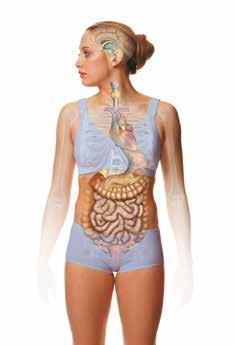
a
Bacteria Phagocyte ‘recognises’ the bacteria
The specific immune response has two forms of attack. B cells produce special molecules called antibodies. These antibodies fit exactly onto a specific part of the pathogen (Figure 3). Each antibody will fit only one section of the pathogen. This causes the pathogens to become locked together and stops them invading.
T cells then recognise the same specific pathogen and attack and kill it. B and T cells may take up to a week to recognise and destroy a pathogen. This is why recovering from an illness takes time.
Both B and T cells keep some memory cells alive, just in case the pathogen tries to invade again. This means the pathogen will be attacked and killed before it can cause damage a second time. Your body will be protected from reinfection in the future. You are now immune.
Unborn babies obtain some natural immunity by receiving antibodies through the B cell an immune system cell that produces antibodies in response to pathogens antibody a molecule produced by B cells that binds to a specific pathogen T cell an immune system cell that recognises and kills pathogens memory cell an immune system cell produced in response to an infection; retains the memory of how to fight the pathogen immune able to fight an infection as a result of prior exposure
Phagocyte ingests bacteria by ‘ owing’ around them
Phagocyte digests bacteria using enzymes Figure 2 The process of phagocytosis
placenta from the mother. Antibodies are also passed to babies through breast milk.
Another way to acquire immunity is by ingestion or injection with specific small parts of the pathogen. This is called vaccination, or inoculation. A vaccine can be made up of: > the dead pathogen > a living but non-virulent (weakened) form of the pathogen > parts of the broken-up pathogen > genetic material from a viral pathogen.
Through vaccination, a person makes antibodies and memory cells that will recognise the pathogen in the future, which usually leads to immunity. Vaccinations are often given as a preventive measure. For instance, the influenza vaccine is recommended for people over 65 years of age because complications from influenza can be life-threatening in older people. Vaccination can also be given when there is an urgent need to provide immunity, such as preventing Covid-19. For example, the modified genetic material from the SARS-CoV-2 coronavirus can be used for vaccination. This means a person will have antibodies and T cells already activated in their body to prevent the virus from causing damage and Covid-19 symptoms. A virus is killed or weakened, and given to the person. vaccination an injection of an inactive or artificial pathogen that results in the individual becoming immune to a particular disease
Antibodies are made by the person but there is no illness.
Exposure to the active virus results in a fast antibody response. Figure 4 A person can become protected or immune actively through vaccination, or passively by antibodies being passed on to them in breast milk from their mother when they are a baby. Pathogen binds here. Region is specific to the pathogen
Antibody Antigen Figure 3 a Each antibody Pathogen has a region that is specific to a particular pathogen. b Antibodies cause pathogens to clump together. Remember and understand 1 Describe the body’s major first line of defence. 2 Describe one other way the body can prevent pathogens from entering. 3 Describe in your own words how the non-specific immune response works. Apply and analyse 4 Compare (the similarities and differences between) the second and third levels of defence.
3.10 Check your learning 5 Compare the different types of vaccines. 6 Describe how a vaccine prevents a person from ‘catching’ a disease. 7 Newborn babies cannot be vaccinated against whooping cough until they are 2 months old. The antibodies in breast milk are not enough to protect them from this deadly disease. Explain why it is important for everyone who comes into contact with the baby to be vaccinated against whooping cough.
Pathogen binds here. Region is specific to the pathogen Antibody Pathogen b Antigen DRAFT ONLY - NOT FOR SALE
3.11
Things can go wrong with the immune system
In this
topic, you • Allergies result from an overactive immune system. will learn • Autoimmune diseases such as type 1 diabetes and rheumatoid arthritis are caused that: by the immune system attacking the rest of the body. • HIV is a virus that specifically attacks T cells, resulting in acquired immune deficiency syndrome (AIDS). The immune system coordinates attacks on attacking it. Inflammation occurs, resulting pathogens that are trying to disrupt the body. in an increased amount of blood reaching the The coordination of all the cells and chemical area. Fluid leaks out of the blood vessels and molecules is very complex, and can easily be the area becomes red and swollen. This also disrupted. contributes to a runny nose and watering eyes, as your body tries to flush out the pollen. allergy Hay fever and other Phagocytes also invade the area in an an overreaction by the immune system in response to pollen, dust or other non-pathogens allergies Allergies result when your immune system attempt to destroy the pollen. If you have been exposed to the pollen before, then your body will already have antibodies that speed up this mistakes a harmless substance as dangerous. reaction. In extreme cases, the person’s throat anaphylaxis a life-threatening This means the body overreacts. A common will swell shut, making it difficult to breathe. overreaction by the example is plant pollen, mainly from grass but The large amount of fluid leaking from the immune system to a also from trees, which can cause hay fever. blood vessels can also cause the blood vessels normally harmless When the pollen gets in your eyes or nose, to collapse. This life-threatening response is substance your second and third lines of defence start called anaphylaxis. One tree can produce millions of pollen spores. Grass pollen is the most common cause of hay fever. Once in contact with your eyes and nose, pollen causes irritation, sneezing and itching (in ammation). 2 4 Hot summer days with no breeze allow pollen to build up.

1
3 DRAFT ONLY - NOT FOR SALE
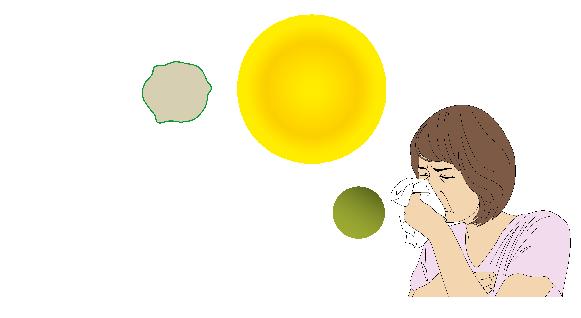
Figure 1 How hay fever happens
3.11 Check your learning Remember and understand Apply and analyse
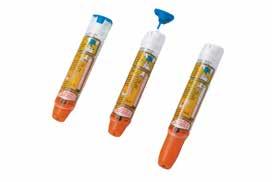
Type 1 diabetes is also caused by an autoimmune reaction against the cells in the pancreas that produce insulin. As a result of attack by B cell antibodies and T cells, these pancreatic cells are destroyed. This means the person is unable to control their own blood glucose levels and instead must test their glucose levels regularly and inject artificial insulin when it is needed. HIV causes AIDS The human immunodeficiency virus (HIV) infects a special type of T cells in the immune system. This makes the whole immune system ineffective. A person with HIV has a weakened immune system. This causes them to develop a range of infections that a normal immune system would be able to destroy easily. For example, simple fungal infections, viral eye infections and diarrhoea (loose bowel motions) can make a person infected with HIV very sick. Collectively these symptoms are called acquired immune deficiency syndrome (AIDS). Figure 3 Inflammation causes the joints of rheumatoid arthritis sufferers to swell and become painful.
Figure 4 If the immune system is ineffective, opportunistic pathogens such as yeast can grow out of control.
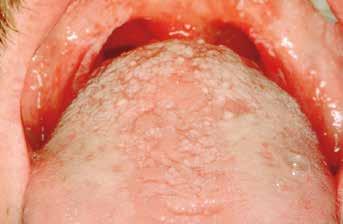
type 1 diabetes an autoimmune disease in which the immune system attacks the insulinproducing cells in the pancreas rheumatoid arthritis an autoimmune disease in which the immune system attacks the joints of the body Figure 2 Epipens deliver adrenalin to people suffering anaphylactic shock. Autoimmune diseases Autoimmune diseases are a group of diseases that result from your body’s immune system identifying healthy parts of your own body as a pathogen. Rheumatoid arthritis is an autoimmune disease in which the body produces B and T cells that attack the joints of the body. B cells produce antibodies, and T cells try to destroy the synovial membrane that lines the joint. This causes the joint to swell with fluid, which causes heat and pain for the sufferer. DRAFT ONLY - NOT FOR SALE 1 Explain why hay fever causes a runny nose and watery eyes. 2 Explain why hay fever is always worse the second time you are exposed to pollen. 3 Explain why a person with rheumatoid arthritis has swollen finger joints. 4 Explain why people with type 1 diabetes are unable to produce their own insulin. 5 Contrast HIV and AIDS. 6 Explain why eating even a small quantity of peanuts can cause death in some people.
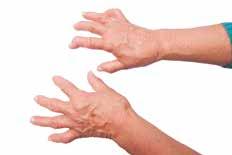
Multiple choice questions
Apply and analyse

1 Identify which of the following is the stimulus.
A a target cell that has a receptor
B a hormone released into the bloodstream
C a change in the environment that disrupts homeostasis
D a response by the body that restores the homeostatic balance 2 Which of the following cells produce antibodies?
A B cells
B phagocytes
C T cells
D viruses 3 Select which of the following is not a pathogen.
A fungi
B bacteria
C adrenalin
D yeast Short answer questions Remember and understand 4 Define the following terms: a stimulus b homeostasis c pathogen. 5 Describe three ways the human body can receive a stimulus from the environment. 6 Identify two glands in humans that produce hormones. 7 Explain why the nervous system and the endocrine system are both described as communication systems. 8 Describe how hormones are transported in the body. 9 Describe three major features of the body’s first line of defence. 10 Describe an example of an infectious disease. 11 Describe how an antibody is used by the body to prevent a pathogen from spreading around the body. 12 Explain why it is important to have certain vaccinations before travelling overseas. Identify two examples of diseases you may need to be vaccinated against. 13 Explain how the immune system’s third line of defence remembers pathogens in case you are exposed to the pathogen a second time.
14 Use an example to explain how a negative feedback mechanism works. 15 Complete this sentence by inserting the missing words. A person with diabetes has a problem with the hormone ___________, which is secreted by the ___________. 16 When a person drinks a litre of water, their body produces extra urine. Use the concept of homeostasis to explain why. 17 Transmission of pathogens can cause mass outbreaks of a disease and affect large numbers of people. Examples are Covid-19, HIV, the SARS virus, swine flu, and the outbreak of cholera in Zimbabwe. Choose one disease and explain how it can spread so quickly. Describe what can be done to prevent the spread of such diseases. 18 Explain how the endocrine system assists your body to ‘respond to the world’. Explain why your body also needs a nervous sytem. Evaluate 19 Explain why holding your nose might help you to swallow something that tastes awful. 20 Predatory animals have their eyes on the front of their face, while their prey generally have eyes on the sides of their heads. Explain the advantage for predators in having eyes on the front of their face. Figure 1 Drinking water after exercising is an important part of homeostasis. DRAFT ONLY - NOT FOR SALE
Figure 2 Jaguars prey on deer, reptiles and fish.
21 In Canada in 2006, a woman fought off a polar bear with her bare hands when it attacked her son. She literally wrestled the bear and won! Explain why this reaction could be attributed to the hormone adrenalin.
22 Compare viruses, bacteria and protozoa, which are all pathogens. 23 Given that people have usually caught a cold before, explain why we continue to catch colds. 24 Your body is constantly monitoring and controlling the numbers of pathogens in and on it. Describe what you can do to assist your body in controlling pathogens. 25 The hygiene hypothesis suggests that childhood exposure to microbes and certain infections helps the immune system develop. As a result of potentially being too hygienic, developed countries continue to see a rise in autoimmune conditions such as asthma and anaphylaxis.
Investigate these conditions, and outline the role of the body’s own immune response in causing the symptoms. 26 Describe in your owns words how the non-specific immune response works.
Social and ethical thinking 27 Babies can be vaccinated against a wide range of diseases in the first months and years of their lives. They are not old enough to choose to be vaccinated, so the decision is made by their parents or guardians. Find out which vaccinations are available and present the arguments for and against giving them to babies. 28 A person with Alzheimer’s disease can often forget what has happened in the past 30 minutes. An example of this is forgetting they have already eaten their lunch. This means the person can become very frustrated and upset if they think they are being refused food. Their carers may explain (many times) that the person has already eaten, but this can upset the person more, as they think they are being lied to.
Other carers may lie to the person and say that lunch will ready in five minutes. This settles the person, who will often forget about eating in that time. Identify which approach you would use. Justify your decision by describing the factors you considered when making your decision. Critical and creative thinking 29 Draw a cartoon strip with at least five squares, illustrating a person receiving a stimulus and then responding. 30 Create a visual presentation on the role of the different types of white blood cells in attacking pathogens.
31 Alcohol blocks the production of ADH. Use critical thinking to predict the effect this will have on urine volume. 32 Construct a table that distinguishes between the different lines of defence. 33 Louis Pasteur found that heat could kill micro-organisms in milk. This discovery is still in use today. Investigate the use of heat in killing pathogens. a Identify two reliable sources. b Summarise one use of heat. Research 34 Choose one of the following topics for a research project. A few guiding questions have been provided, but you should add more questions that you wish to investigate. Present your report in a format of your own choosing. » Type 2 diabetes The incidence of type 2 diabetes is increasing. Compare type 1 and type 2 diabetes. Identify the factors that contribute to the cause of type 2 diabetes. Describe the complications that can result from diabetes. Describe what you can do to prevent type 2 diabetes. » Artificial skin Investigate the work of Australian scientists Dr Fiona Wood and Dr Marie Stoner on skin regeneration, including spray-on skin. Explain why their area of research is so important. Explain how this research is » Stem cells for spinal injury Nerve cells do not easily regenerate and so, to date, it has not been possible to repair damage to the spinal cord. Scientists have been researching the use of stem cells in the treatment of spinal cord injury. Identify the different types of stem cells. Describe how stem cells are used. Describe the advances that have been made in this field of research. Describe one of the issues that have affected such research. DRAFT ONLY - NOT FOR SALE related to the increase in bushfires that is expected to occur with global warming.
Reflect
The table below outlines a list of things you should be able to do by the end of Chapter 3 ‘Control and regulation’. Once you’ve completed this chapter, use the table to reflect on your ability to complete each task.
I can do this. I cannot do this yet. Identify the five senses and the receptors associated with each type of stimulus. Relate the structures of the sense organs to the types of stimulus they receive.
Go back to Topic 3.1 ʻReceptors detect stimuliʼ Page 48 Describe the passage of information through a neuron, across the synapse and to the next cell. Explain how sensory, motor and interneurons communicate information around the body.
Go back to Topic 3.2 ʻNerve cells are called neuronsʼ Page 52 Describe the stimulus–response model. Relate reflex action with potentially life-saving actions.
Go back to Topic 3.3 ʻThe nervous system controls reflexesʼ Page 54 Describe the roles of the central nervous system, peripheral nervous system, somatic nervous system and autonomic nervous system. List the lobes of the brain and describe their main functions.
Go back to Topic 3.4 ʻThe central nervous system controls our bodyʼ Page 56 Provide examples of diseases and problems affecting the nervous system. Relate the importance of myelin sheath to motor neurone disease.
Go back to Topic 3.5 ʻThings can go wrong with the nervous systemʼ Page 58 Describe the fight, flight or freeze response. Go back to Topic 3.6 ʻThe endocrine system causes long-lasting effectsʼ Page 60 Describe the advantage of homeostasis. Explain how hormones regulate blood glucose. Go back to Topic 3.7 ʻHomeostasis regulates through negative feedbackʼ Page 62 Describe the function of erythropoietin and how athletes may use it to improve their performance in sporting events. Go back to Topic 3.8 ʻScience as a human endeavour: Hormones are used in sportʼ Page 66 Provide examples of pathogens. Relate scientific discoveries to the development of the ‘germ theory’. Go back to Topic 3.9 ʻScience as a human endeavour: Pathogens cause diseaseʼ Page 68 Describe some of the body’s first-line defence mechanisms against infection. Compare naturally acquired immunity with vaccinations. Go back to Topic 3.10 ʻThe immune system protects our body in an organised wayʼ Page 70 Describe the immune response during an allergic reaction. Describe the common symptoms of rheumatoid arthritis and type 1 diabetes. Describe the cause of HIV and relate it to the development of AIDS.
Go back to Topic 3.11 ʻThings can go wrong with the immune systemʼ Page 72 DRAFT ONLY - NOT FOR SALE
Check your Student obook pro for these digital resources and more: Check your Teacher obook pro for these digital resources and more:
Compete in teams to test your knowledge. Chapter quiz Test your understanding of this chapter with one of three chapter quizzes. Launch a quiz for your students on key concepts in this chapter.




